Ten years ago the Cook company invited me to interview the pioneers of the revolutionary ERCP procedure, 40 years after the first description of sphincterotomy. There were two publications, covering 15 pioneers from 9 countries. Many of the pioneers have since passed. I have written earlier at length about Meinhard Classen and Kees Huibregste.
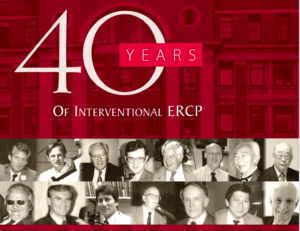
Two more giants have fallen. The time has come to reflect on and celebrate Claude Liguory (France) and Laszlo Safrany (Hungary/Germany), seen next to each other on the left side of the second row.
It happens that I first met them both at the same meeting in 1972. The Olympus company (that made and make most of our instruments) held a meeting in Paris of the dozen or so endoscopists getting started with ERCP in Europe. Claude was the consumate host and we did some procedures at his hospital. We had a marvellous reception halfway up the Eiffel tower. I never knew why he always wore dark glasses. I regret that my poor french meant that our conversations were often brief and lacking depth. But I became very fond of him.

A tribute from the Cook company: “Dr. Liguory started in surgery back in 1967 in Paris but gravitated to laparoscopy because, in his own words, “surgery took too long”. He decided to choose a specialty that used much more the hands than the brain. As there were no believers of endoscopy at this time Dr. Liguory taught himself and dedicated his work to flexible endoscopy. Dr. Liguory first learned about ERCP during a lecture by Dr. Oi, the first Japanese physician doing ERCP. In November of 1971, Dr. Liguory completed his first ERCP and later traveled to Brazil to introduce the procedure. A few years later, Dr. Liguory completed his first sphincterotomy. There wasn’t any material available in the market at this time, so he used a catheter and fishing wire to create his own sphincterotome! Dr. Liguory worked in various hospitals throughout his career, which allowed him to take new techniques and procedures to these hospitals. At Cochin Hospital in Paris, Dr. Liguory worked with Prof. Lucien Leger, who was head of the surgical unit. Prof. Leger was excited about new procedures, especially endoscopic papillotomy and Dr. Liguory did the first papillotomy for acute pancreatitis in 1979. A year later, he then performed the first endoscopic cystostomy while working in Prof. Leger’s department. The relationship between Dr. Liguory and Prof. Leger really helped further Dr. Liguory’s career. He was elected into the National Academy of Surgery in 1987 and two years later was named Professor of the Medical College of Paris Hospitals. Dr. Liguory stopped practicing in December of 2007. He is truly one of the first pioneers of Interventional ERCP. We thank him for all of his contributions to the world of endoscopy”. Something not mentioned there is his longstanding close connexion with South America. He travelled to Brazil countless times and must be personally responsible for the spread and quality of advanced endoscopy there”.
We were at a meeting in Rio together and travelled back on Concorde. The seats were rather small but Claude approved of the wine. He persuaded me to publish in a French medical journal, Endoscopie Digestive, in 1978. It was the first description of minor papilla sphincterotomy for recurrent pancreatitis. In retrospect it was perhaps a good thing that it was thereby somewhat hidden.
I remember Claude with great warmth as a mentor and friend. Along with thousands of lucky patients and students, I carry him in my heart.
My memories of my first meeting with Laszlo Safrany at that meeting in Paris are dominated if not marinated by the Hungarian liquor he brought.


Laszlo was then living in Hungary. It is said that he left there only because he had done ERCP procedures on everyone in that country. If Claude was somewhat reserved, Laszlo was the opposite, always outgoing and ready for action and new adventures. He also was a prolific contributor to the early endoscopic literature. We shared several publications.
George Brownestone kindly just sent me this reminiscence about the man his friends called “Safi”.
My wife, Eva, gastroenterologist and endoscopist, knew him from her med school days in Hungary, over 50 years ago. When she left Hungary after graduation, Safi was already in Germany, and she spent a year learning from him there. I first met him decades ago, when he and Eva planned to write an endoscopy teaching book down in Marbella (never finished), where he and I played golf.
Yes, he was a giant, not only professionally, but in whatever he did. His character: For openers, he was extraordinarily smart, and used his mind wisely and well. He was also highly motivated to be the best he could be in whatever he undertook, and took pride in his achievements. He was also a great athlete. While in med school he was already athletically active, and, I believe, played on the Hungarian Olympic volleyball team. He was one of those guys who always took an extra lap or three after practice.
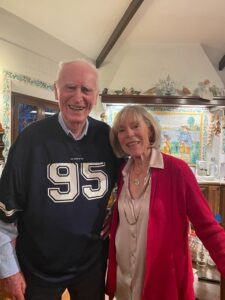

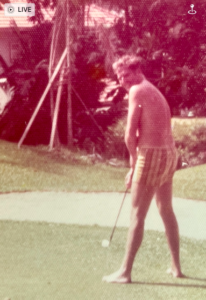
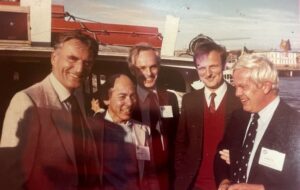
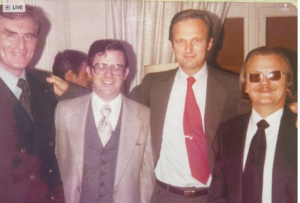
Blessings…..
